
Moscato has become something of a cultural phenomenon in recent days. Over the past few years, demand for Moscato has been on the rise, with consumers looking for a sweeter, lighter bodied wine with a low alcohol content. With its relatively low price point, delicate notes both fruity and floral and undeniable sweetness, this wine is perfect for new wine enthusiasts, yet can be nuanced enough for a seasoned taster to appreciate.
It seems Moscato wine is more than just a passing trend, so if you’re wondering about Moscato wine, we’ve put together a comprehensive guide.
What is Moscato Wine?
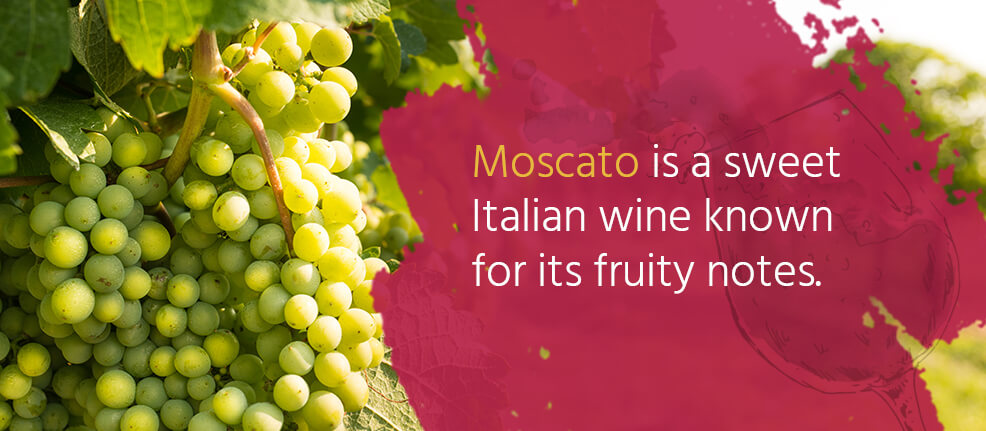
Moscato (pronounced mo-ska-toh) is a sweet Italian wine known for its fruity notes. Made from the Muscat grape, this white wine is typically thought of as a dessert wine with a hint of fizz. Though there’s some variation between the different types, Moscato generally has a pretty low alcohol content, hovering around 5-7%. As a point of reference, most red wines have an alcohol content of about 10-12% ABV. The low alcohol content makes Moscato a great dessert drink for casual sipping, or the perfect addition to a brunch-time spritzer that won’t derail your entire day.
What is Moscato wine made of? Despite variations in fizziness, color, and dryness, all Moscato wines come from the Muscat grape have a relatively similar flavor profile.
Here’s a look at the different types of Moscato:
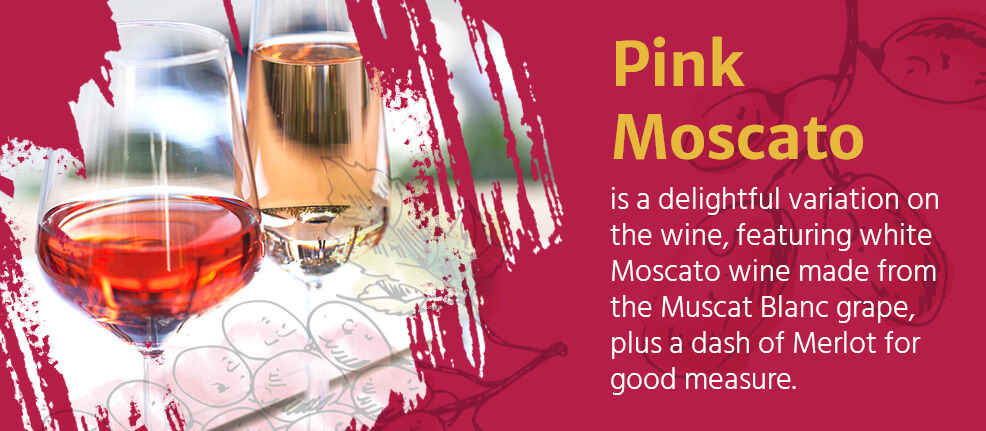
Pink Moscato — Pink Moscato a delightful variation on the wine, featuring white Moscato wine made from the Muscat Blanc grape, plus a dash of Merlot for good measure. Due to its more varied composition, Pink Moscato features an exciting lineup of flavorful nuances — rich caramel and vanilla notes play nicely with the fruitier flavors more closely associated with the common Moscato d’Asti variety — nectarine, peach and citrus.
Asti Spumante — The fully sparkling version of Moscato, Asti Spumante (or simply Asti) is the Muscat Blanc grape’s answer to champagne.
Moscato d’Asti — This is the most common type of Moscato wine. It’s white, sweet and slightly sparkling (what’s known as “frizzante”), and made from the Muscat Blanc grape. Moscato d’Asti is generally what you’ll get if you ask for Moscato at most establishments.
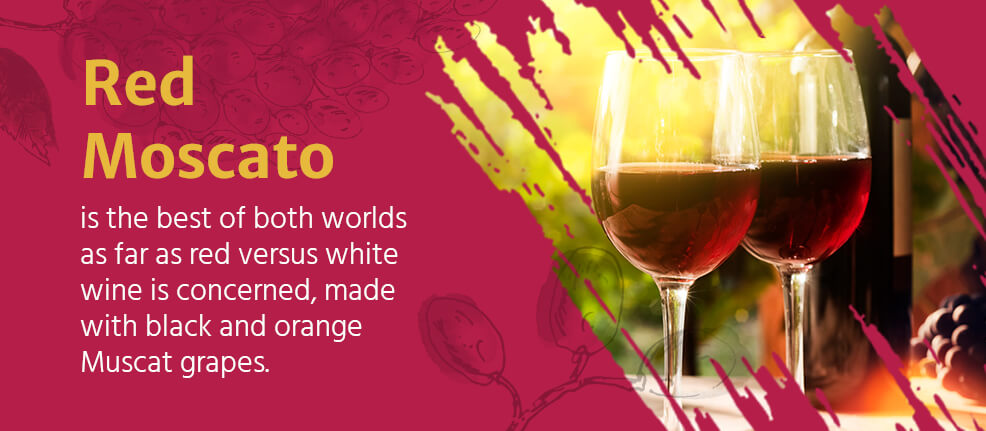
Red Moscato — Made with black and orange Muscat grapes, Red Moscato is the best of both worlds as far as red versus white wine is concerned. While it still has that signature Moscato taste and smell, red Moscato features a range of fruity notes from wild cherry to berry and peach.
Still Moscato — Also known as Moscatel or Muscat Blanc. This Moscato comes without the wine’s signature sparkle, and uses either the Zibibbo or the Muscat Blanc grape. You won’t find this still white wine in every supermarket, but if you do, it’s a bit different, so die hard Moscato fans might not love this as much as their usual bottle. Some it’s interesting to try Moscatos which are completely dry, featuring ABVs that more closely resemble other wines. The alcohol content hovers at around 12%.
Dessert Moscato — Though all Moscatos are quite sweet and have a reputation as a great dessert wine, this oak-aged style is commonly associated with wine made from Moscatel grapes, hailing from various regions in the world — France, the US, South America and more.
Muscat Grapes Go Global
Though it hails from Italy, Moscato grows just about anywhere in the world. From its European origins, Moscato can be grown in almost any climate, though the plant prefers the accommodating warmth of the Mediterranean climate, thriving in France, Spain, Italy, Portugal and certain regions of Australia.
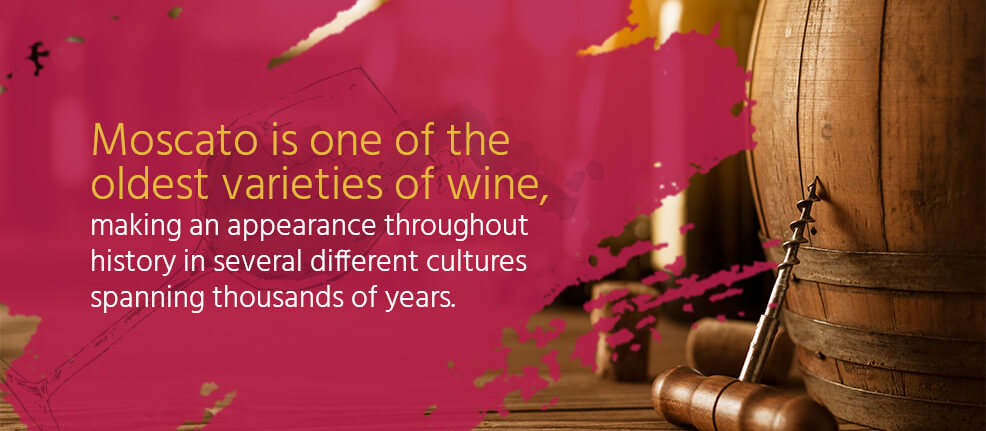
Moscato is one of the oldest varieties of wine, making an appearance throughout history in several different cultures spanning thousands of years. The long history of the grapes throughout has resulted in a variety of mutations and crossings — creating at least 200 variations of the Muscat grape.
Here are the more common varieties of the Muscat grape:
- Muscat Blanc à Petits Grains, or just Muscat Blanc
- Moscatel, also known as Zibibbo or Muscat of Alexandria
- Moscato Giallo (a yellow version of the Muscat Blanc grape from Northern Italy)
- Black Muscat (also known as Muscat Hamburg)
- Orange Muscat
- Muscat Ottonel (a pale, early ripening grape from Eastern Europe)
- Moscatel de Setúbal (Found in Portugal)
Asti and Moscato d’Asti — What’s the Difference?
Despite the well-travelled history of this grape, most Moscato you’ll see comes from a region in Italy, called Asti. Province, town and wine, this triple threat name is part of the Piedmont area in Northwestern Italy
Since the early 1990’s however, Asti Spumante was promoted to DOCG classification, which is the highest designation in Italian wines — quite an achievement. At that point, the wine officially dropped the word “spumante,” in an effort to elevate the wine by getting rid of the suffix. There are countless other wines that use the spumante suffix as well, but it generally refers to a specific wine’s sparkling version, in order to differentiate a wine that isn’t traditionally sparkling. In the region of Asti, the sparkling aspect is essential to its style, so wine experts deemed the qualification was redundant and somehow cheapened the wine itself.
While the name Asti on its own refers exclusively to the fully sparkling version of the white wine, Asti Spumante, as we mentioned Moscato d’Asti refers to the more slightly sparkling wine (frizzante) that we generally associate with the name Moscato.
Moscato d’Asti and Asti are easy to mix up, despite some subtle, yet important differences. With Asti, you’ll get a sweet white wine that is fully sparkling. Its alcohol content is usually around 9%. Moscato d’Asti on the other hand is a little bit sweeter than its sparkling counterpart. This popular white wine has a touch of sparkle — known as frizzante — and has a relatively low ABV of about 5 or 6%.
The main difference between these two types of wine lies in the power of the bubbles. As far as Italian wine experts are concerned, sparkles are a big deal. Asti, the spumante wine of the two, is subjected to a minimum of 4 atmospheres of pressure. On the other hand, the Moscato d’Asti is subjected to 1 atmosphere of pressure.
As a handy trick in case you don’t feel like reading the label too closely, wineries tend to top Asti off with a big wired down cork similar to champagne, because of the pressure, while Moscato d’Asti has a more traditional cork.

Moscato d’Asti is a sweet and delicate wine, and as a result, it takes the bulk of the Asti region’s ripe grapes. Because of this, the less ripe, more acidic leftover grapes are used in the sparkling Asti wine. The higher concentration of alcohol in combination with the higher fizziness doesn’t require the grapes to be as sweet.
Tailor Made for Dessert Pairings
To be sure, sweet and sparkly Moscato is great on its own, but its distinctive aroma can prove tricky when pairing with tasty bites. While Moscato surely won’t stand up against a big steak, it really shines when paired with a dessert menu.
As a general rule, Moscato wines work really well when paired with similar fruit flavors. Pair this wine with a peach or nectarine tart or warm berry pie for a fruit on fruit experience. It also works well with nuttier flavors. The wine’s tasting notes of nectarine and citrus really shine when paired up against the subtle flavors of a buttery almond pastry.
Another great option? Opt for a cheese plate. This wine and cheese combination is a classic that never fails to impress, but you will want to pick cheeses that are light and fresh, rather than aggressively sharp and smelly. Your best bet will be a gorgonzola or a crescenza. Top off with some fresh figs, grapes, nuts or whatever else sounds good and you’ve got the perfect party platter to serve alongside Moscato.
Moscato Dinner Pairings
If you’re looking for something a little more unexpected than a dessert pairing, we’ve got you covered. Believe it or not, Moscato can be a great dinner pairing for certain types of food.

Chinese, Thai and Vietnamese cuisines all work really well with Moscatos. The high aromatic content of these regional cuisines balance out the natural sweetness in Moscato — plus, because the alcohol volume is so low, Moscato works in place of the lighter lagers that are usually served alongside spicier dishes. As an added bonus, the sweetness of Moscato is the perfect choice to balance out the spiciness of a dish such as ginger, cinnamon and hot chili peppers.
Like other white wines, Moscato works best at the dinner table when paired with lighter proteins like chicken or fish. While chicken is always a safe bet, you can also try pairing your wine with a rich barbecue pork or marinated tofu.
Pairing Foods with Pink and Red Moscatos
Being from the same grape means Moscatos all share a general flavor profile — sweet, fruity and a touch woodsy. However, the little differences between add up, shifting the pairing options ever so slightly. Here are a few tips:
- If you’re drinking a Pink Moscato, its hint of Merlot can handle a bit more heartiness. Bring it to the dinner table — try pairing this unique wine with chicken, ham or flaky, buttery seafood like crab or lobster. Though Moscatos typically rule the dessert menu, Pink Moscato is pretty versatile, and can even handle teaming up with a bit of steak.
- If you do opt for the traditional dessert route, keep it simple and pair a Pink Moscato with other vanilla-type flavors that echo the notes present in the wine — think shortcakes, caramels or a shortbread-type cookie.
- Red Moscato on the other hand, though still made with the Muscat grape, tends to stand up to bolder flavors than its lighter counterparts do. Try pairing with BBQ fare, soft cheeses or anything spicy.
Our Favorite Moscato Drink Recipes
Whether you play up the dessert factor or go for a brunch-ready Moscato mimosa, we’ve dug up a few delicious (not to mention, easy to make) Moscato cocktail recipes that offer a bit of a departure from your usual dessert sipper.
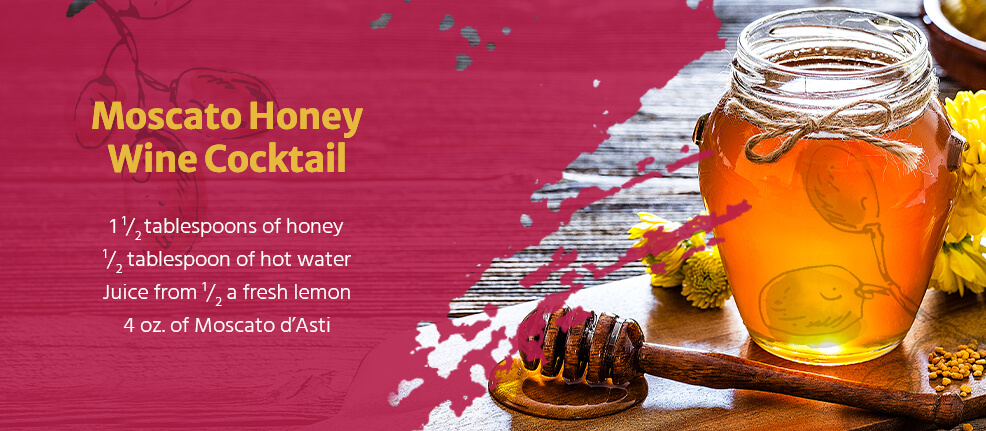
Moscato Honey Wine Cocktail
Moscato meets more sweetness in this easy-to-make drink. Before you dismiss this as sweetness overload, keep in mind pairing basics. The sweet white wine plays nicely with fresh raspberries and the subtle sweetness of the honey. Honey, wine and fresh fruit come together to create a perfectly refreshing drink that can easily take the place of dessert.
Ingredients
- 1 ½ tablespoons of honey
- 1/2 tablespoon of hot water
- Juice from ½ a fresh lemon
- 4 oz. of Moscato d’Asti
Instructions
- Mix the honey with the hot water in a glass, stirring until the honey has fully dissolved in the liquid.
- Next, add the Moscato and the lemon. Stir until all ingredients are completely mixed.
- Top off with ice and garnish with a lemon slice and mint leaf for a little extra oomph.
- Drizzle honey over the top and serve.
Apple Cider Sangria with Red Moscato
A unique take on the sangria, this version brings the summertime staple right into the fall and winter months. Made with apple cider and a delicious lineup of seasonal fruits, this Red Moscato Sangria is the perfect drink to serve at a low-key weekend get together, or just a regular Tuesday night.
Ingredients
- 1 bottle Red Moscato
- 1 cup apple cider
- 1/2 cup fresh, pitted black cherries
- 1/2 cup cranberries
- 1 cup cubed granny smith apples
Directions
- First, pour the bottle of wine into a large pitcher
- Next, you’ll add the apple cider and all fruits
- Gently stir all ingredients until evenly dispersed
- Let the Sangria sit for at least an hour so the wine can absorb the fruit flavors.
- Enjoy — serve with ice, if desired.
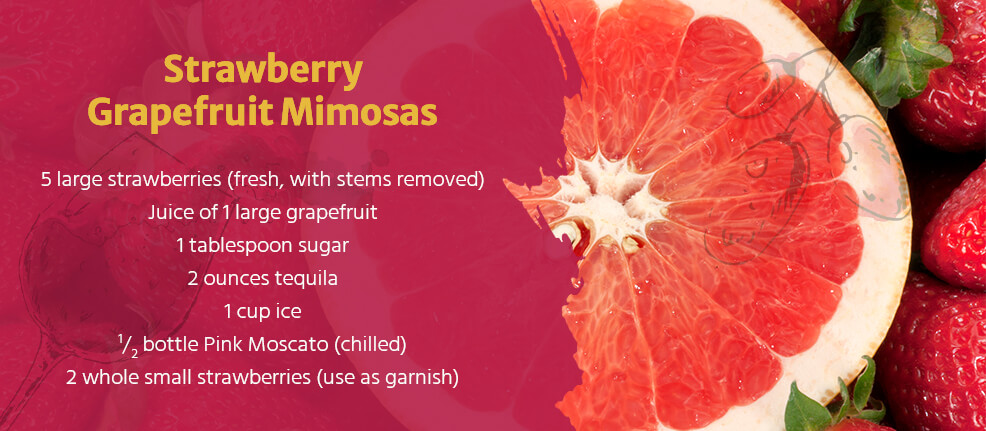
Strawberry Grapefruit Mimosas
The perfect drink for a special occasion, this fruity drink breathes new life into the classic all-you-can-drink brunch staple. Sweet Moscato wine pairs nicely with strawberries, the contrasting tartness of grapefruit and the little kick of tequila.
Ingredients
- 5 large strawberries (fresh, with stems removed)
- Juice of 1 large grapefruit
- 1 tablespoon sugar
- 2 ounces tequila
- 1 cup ice
- 1/2 bottle Pink Moscato (chilled)
- 2 whole small strawberries (use as garnish)
Instructions
- Add strawberries, sugar and grapefruit juice to a blender, combining until completely smooth.
- Next, strain the fruit mixture into a cocktail shaker, adding the tequila and ice.
- Shake it up until cold and thoroughly mixed.
- Then, strain the fruit and tequila mixture into a champagne flute or wine glass (so as to remove the ice), filling glasses half way.
- Top drinks off with the Pink Moscato and enjoy.
Asti with Coriander and Lime
Sure, this simple Asti cocktail only has three ingredients, but sometimes less is more. This sparkling drink provides the perfect after-work relief on a hot evening.
Ingredients
- 1 bunch fresh cilantro or coriander
- 1 bottle of chilled Asti Spumante
- 1 lime — juiced
Instructions
- First, bruise the coriander or cilantro. Just a quick FYI: “bruising” the coriander means you’ll just slightly crush the herbs to release the flavor, rather than cutting it into small bits.
- Next you’ll combine the herbs with the chilled Asti, adding in the juiced lime. Stir well until combined.
Moscato FAQs
Want to learn more about Moscato? Take a look at these FAQs and see if we can answer your questions!
Is Moscato Sweet or Dry?
Moscato is considered a sweet wine due to its lower acidity and high levels of residual sugar. The wine’s exact sweetness and flavor will depend on the winemaker’s style. To get Moscato’s signature sweetness, most winemakers stop the fermentation process earlier than with other blends, resulting in a crisp, sweet finish.
Moscato is part of the dessert wine family along with other popular sweet wines like Zinfandels and Tokajis.
Is Moscato a Wine or Champagne?
Moscato is most certainly a variety of wine. However, some kinds of Moscato are sparkling, and it does share a few commonalities with Champagne, including:
- A lower alcohol content
- Generally white, but can have rosé and blush options
- Light, sweet flavors
The main difference between Moscato and Champagne is their fermentation and carbonation processes. Champagne gets carbonated through a secondary fermentation process, while Moscato is fermented with carbon dioxide, leaving slight carbonation behind.
What Kind of Wine Is Moscato?
This light, sweet wine often pairs with desserts, so it’s no surprise that Moscato is a dessert wine. While there’s no universal way of defining “dessert wine,” wines in this category generally have sweeter, more pronounced flavors that pair well with fruit and confectionery. They also tend to have more residual sugar after the fermentation process, adding to their sweetness.
Due to its slight carbonation, there are not many other dessert wines that have a flavor profile like Moscato’s. If you’re hoping to add some variety to your collection, though, consider a Prosecco or a sparkling Riesling.
Is Moscato Considered Cheap Wine?
Moscato is a highly accessible wine, and as such, adding this wine to your everyday repertoire won’t break the bank. Most bottles are well below triple-digit prices, so you can indulge in enough to satisfy all your friends and family.
While some people may consider “cheap” wine to be of lesser quality, in this case, it simply means it’s easy to drink and easy to share. In recent years, Moscato has gained quite a following, and people from all backgrounds have found something to enjoy in this wine. If you like a light, sweet drink to finish off your meal and ease you into your evening, Moscato is an excellent choice.
Whether you’re out at a friendly picnic or hosting an important dinner party, you’re sure to please the crowd with a bottle — or a few! — of Moscato at your side.
Is Moscato Wine Dry or Sweet?
As a dessert wine, Moscato is firmly in the sweet wine family. Other popular sweet wines include Zinfandels and Tokajis. The wine’s exact sweetness will depend on the winemaker’s style, but usually, sweet wines have more residual sugar than dry wines. To get Moscato’s signature sweetness, most winemakers stop the fermentation process earlier than with other blends, resulting in a crisp, sweet finish.
Buy Moscato Wine Online
Looking for Moscato wine delivered directly to you? Look no further than Marketview Liquor. We’ve got it all from your basic (and delicious) Moscato d’Asti to the more colorful pinks and reds, as well as the sparkling, suffix-optional Asti.
Check out our extensive selection of wines to find the best Moscato wines at the best prices, plus free shipping on select bottles of twelve or more. Additionally, mix and match a variety of select bottles to be eligible for a 10% case discount!

